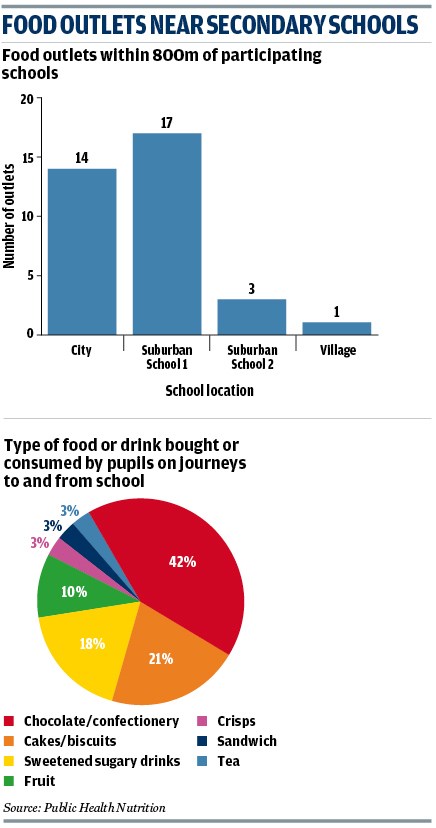Research Report: Opportunities for Food and Drink Purchasing and Consumption by Teenagers
Charlotte Goddard
Monday, May 11, 2015
Researchers examine the choices young people make when buying and eating food on the way to and from school. Authors Gill Cowburn, Anne Matthews, Aiden Doherty, Alex Hamilton, Paul Kelly, Julianne Williams, Charlie Foster and Michael Nelson, University of Oxford and University of Edinburgh, Public Health Nutrition Research
Authors Gill Cowburn, Anne Matthews, Aiden Doherty, Alex Hamilton, Paul Kelly, Julianne Williams, Charlie Foster and Michael Nelson, University of Oxford and University of Edinburgh, Public Health Nutrition Research
Published by Public Health Nutrition, April 2015
SUMMARY
While the introduction of school food standards has made it easier for young people in England to make healthy choices at lunchtime and throughout the school day, there is little known about what influences their food choices beyond the school gate. The research team wanted to investigate the choices made by young people when buying and eating food on the way to and from school. In doing so they were interested in trialling a new method of research involving wearable cameras which would record teenagers' journeys to and from school and the purchases they made. The researchers wanted to find out if this would help young people remember more accurately what they bought.
The cameras take pictures every ten to 15 seconds and take additional pictures when the environment changes such as when a young person walks into a shop.
Students from four schools in Oxfordshire and Yorkshire took part in the study – Exploring the Opportunities for Food and Drink Purchasing and Consumption by Teenagers During their Journeys Between Home and School: A Feasibility Study Using a Novel Method.
One school was in a city, one was a village school and two were in suburban areas. In addition to the cameras, young participants carried GPS devices to track their journeys over four school days. The young people also filled in a food and travel diary and were interviewed at the end of the four days. Each school also held a focus group and the researchers collected data about the schools' food provision and food outlets located within 800m of the schools.
Twenty-two young people took part in the study – four from the city school and six from each of the others. Numbers were constrained by the number of cameras available. In total 173 journeys were recorded and 38 items of food and drink were bought or consumed by participants en route. Most commonly items were high in energy, fat and sugar. Forty-two per cent were chocolate or confectionery, 21 per cent were cakes and biscuits and 18 per cent were sugary drinks. Only four of the items were fruit.
All of the items were bought or consumed by 15 of the participants during 28 of their journeys. Most commonly the young people were consuming food or drink they had already bought in school or items left over from their packed lunch. Some bought food on the way home to eat during their journey but others bought food to eat later, for example at an after-school club. Seven were regular purchasers or consumers of food on their journeys while the other eight only did so once.
The researchers found the city school had 14 food outlets within 800m, the village school had one. Of the two suburban schools, school one had 17 food outlets within 800m and school two had three. Just over half the food and drink items were bought or consumed within 800m of the school. The young people from suburban school two were the most likely to buy or consume food or drink, with five young people buying or consuming 15 items between them.
The researchers suggest the behaviour of the young people may have been driven by their transport modes and travel routes. The more freedom participants had to go where they wanted between home and school, the more likely they were to engage with the food outlets around them.
Rural schools had fewer food opportunities than those in urban settings. Interpersonal factors such as peer group socialising and individual factors such as attitudes to health and money were also influential.
IMPLICATIONS FOR PRACTICE
The use of wearable cameras prompted detailed discussion and generated specific information which could offer new understanding and insights around eating behaviour patterns.

FURTHER READING
Does the Local Food Environment Around Schools Affect Diet? Longitudinal Associations in Adolescents Attending Secondary Schools in East London, Dianna Smith, Steven Cummins, Charlotte Clark and Stephen Stansfeld, BMC Public Health, January 2013. A study investigating how the local retail food environment around secondary schools has changed over time and whether this change is associated with a change in students' diets.
Obesity-promoting Food Environments and the Spatial Clustering of Food Outlets Around Schools, Peter Day, Jamie Pearce, American Journal of Preventive Medicine, February 2011. A New Zealand study looking at whether food outlets are clustered around schools.
The School Food Environment Associations with Adolescent Soft Drink and Snack Consumption, K van der Horst, A Timperio, D Crawford, R Roberts, J Brug, A Oenema, American Journal of Preventive Medicine, September 2008. A survey of 1,293 12- to 15-year-olds in the Netherlands, investigating soft drink and snack consumption relating to nearby food stores and the school canteen.




